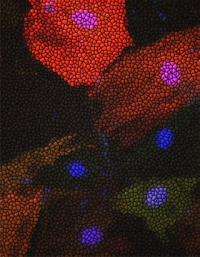Making use of cellular 'noise'

(PhysOrg.com) -- While some scientists find it messy that cells of the same type will respond differently to identical stimuli, Duke University bioengineers have turned this cellular noise to their advantage.
In doing so, they discovered important insights into the cues that tell cells when to begin to make copies of themselves, a process known as the cell cycle.
The Duke scientists knew that the expression of a particular gene is responsible for launching the cell cycle and it has the capability to tell a cell to go into hibernation or kill itself, like a cellular dead-man’s switch. This same gene is also known to be present in increased amounts in several types of human cancer.
Understanding what flips the switch could provide a new avenue for treating diseases marked by abnormal cell proliferation, such as cancer. The Duke scientists used a commonly observed but often ignored phenomenon – cell-to-cell variability in virus infection – to deliver increasing amounts of this gene to a population of rat fibroblast cells growing in culture, and observed its effects on certain indicators of proliferation. This variability of gene expression within a genetically identical population of cells is termed noise.
“Over the past 10 years, many studies have looked at this phenomenon of noise, and biologists have often found this variability to be messy,” said Lingchong You, assistant professor of biomedical engineering at Duke’s Pratt School of Engineering. “Here, we took the opposite approach. When coupled with single-cell measurements and computer modeling, this variability provides an efficient means to measure and understand how levels of gene expression affect signaling dynamics in mammalian cells.”
The results of the Duke experiments were published online in the journal Molecular Cell. Jeffrey Wong, post-doctoral fellow in You’s laboratory, was first author of the paper. The research was supported by the National Institutes of Health, a David and Lucille Packard Fellowship, and a DuPont Young Professorship.
The gene studied by the Duke team is known as c-Myc. It is believed that this single gene participates in regulating as much as 15 percent of all human genes. When mutated, this gene has been implicated in many forms of cancers. “The amount, or dosage, is key,” Wong said. “We found that as the amount of c-Myc increased, the expression of an important protein also increased, but then subsequently decreased as the amount of c-MYC continued to increase.” The protein is called E2F1, which is vital to the cell cycle process and can act as a tumor suppressor.
Under normal circumstances, low levels of c-Myc provide the trigger for the production of E2F1, which in turn tells the cell to start dividing. Researchers introduced increasing amounts of c-Myc into rat cells growing in culture and found that as the amount reached higher levels, the cells’ first response was not to proliferate normally, but to remain quiescent instead.
“This response of normal cells to high levels of c-Myc is, depending on the type of cell, either to remain inactive or to commit suicide. It’s like a built-in safeguard against over-proliferation,” You said.
However, abnormal cells in tumors might find a way around this barrier. In these cases, amplification of c-Myc and additional mutations may cooperate to upset normal constraints on growth control, You said, which could be a key to the emergence of aggressive cancers.
Other members of the Duke team were Guang Yao and Joseph Nevins. Yao has recently started his own lab in the University of Arizona.
More information: "Viral-Mediated Noisy Gene Expression Reveals Biphasic E2f1 Response to MYC," Jeffrey Wong et al. Molecular Cell, 4 February, 2011. doi:10.1016/j.molcel.2011.01.014
Provided by Duke University
















